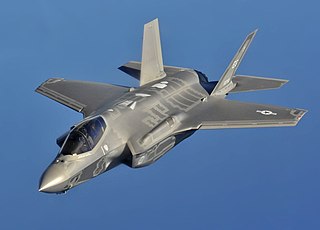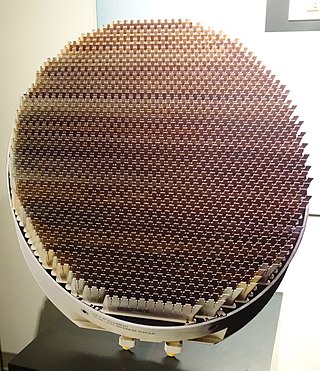Related Research Articles

The Lockheed Martin F-35 Lightning II is an American family of single-seat, single-engine, all-weather stealth multirole combat aircraft that is intended to perform both air superiority and strike missions. It is also able to provide electronic warfare and intelligence, surveillance, and reconnaissance capabilities. Lockheed Martin is the prime F-35 contractor, with principal partners Northrop Grumman and BAE Systems. The aircraft has three main variants: the conventional takeoff and landing (CTOL) F-35A, the short take-off and vertical-landing (STOVL) F-35B, and the carrier-based (CV/CATOBAR) F-35C.

The Northrop Grumman RQ-4 Global Hawk is a high-altitude, remotely-piloted surveillance aircraft introduced in 2001. It was initially designed by Ryan Aeronautical, and known as Tier II+ during development. The RQ-4 provides a broad overview and systematic surveillance using high-resolution synthetic aperture radar (SAR) and electro-optical/infrared (EO/IR) sensors with long loiter times over target areas. It can survey as much as 40,000 square miles (100,000 km2) of terrain per day, an area the size of South Korea or Iceland.

Northrop Grumman Corporation is an American multinational aerospace and defense technology company. With 95,000 employees and an annual revenue in excess of $30 billion, it is one of the world's largest weapons manufacturers and military technology providers. The firm ranks No. 101 on the 2022 Fortune 500 list of America's largest corporations.
The Northrop Grumman E-10 MC2A was planned as a multi-role military aircraft to replace the Boeing 707-based E-3 Sentry and E-8 Joint STARS, the Boeing 747-based E-4B, and the RC-135 Rivet Joint aircraft in US military service. The E-10 was based on the Boeing 767-400ER commercial airplane.

An active electronically scanned array (AESA) is a type of phased array antenna, which is a computer-controlled antenna array in which the beam of radio waves can be electronically steered to point in different directions without moving the antenna. In the AESA, each antenna element is connected to a small solid-state transmit/receive module (TRM) under the control of a computer, which performs the functions of a transmitter and/or receiver for the antenna. This contrasts with a passive electronically scanned array (PESA), in which all the antenna elements are connected to a single transmitter and/or receiver through phase shifters under the control of the computer. AESA's main use is in radar, and these are known as active phased array radar (APAR).
Northrop Grumman Electronic Systems (NGES) was a business segment of Northrop Grumman from 1996 to 2015 until a reorganization on January 1, 2016, merged other Northrop Grumman businesses into NGES to form a new segment called Mission Systems. NGES had originally been created by Northrop Grumman's acquisition of Westinghouse Electronic Systems Group in 1996. The Electronic Systems sector was a designer, developer, and manufacturer of a wide variety of advanced defense electronics and systems. The division had 120 locations worldwide, including 72 international offices, and approximately 24,000 employees; accounting for 20% of company sales in 2005.

The AN/APG-66 radar is a solid state medium range pulse-Doppler planar array radar originally designed by the Westinghouse Electric Corporation for use in the F-16 Fighting Falcon. This radar was employed in all domestic and export versions of the F-16 A/B models throughout the production. Subsequent upgrades have been installed in many varying aircraft types, including the U.S. Customs and Border Protection's C-550 Cessna Citation, US Navy P-3 Orion, and Piper PA-42 Cheyenne II's, as well as the Small Aerostat Surveillance System (SASS). Primary air-combat mode is look-down. In that mode, the AN/APG-66 can detect a fighter-size plane at a range of 34.5 Nautical miles. Four modes are available in air-to-air combat. In dogfight mode, the radar scans a 20 degrees x 20 degrees field. In high-g maneuvers, it scans a 40 degrees x10 degrees pattern. The radar system consists of the following line-replaceable units:

The AN/APG-63 and AN/APG-70 are a family of all-weather multimode radar systems designed by Hughes Aircraft for the F-15 Eagle air superiority fighter. These X band pulse-Doppler radar systems are designed for both air-air and air-ground missions; they are able to look up at high-flying targets and down at low-flying targets without being confused by ground clutter. The systems can detect and track aircraft and small high-speed targets at distances beyond visual range down to close range, and at altitudes down to treetop level. The radar feeds target information into the aircraft's central computer for effective weapons delivery. For close-in dogfights, the radar automatically acquires enemy aircraft and projects this information onto the cockpit head-up display. The name is assigned from the Army Navy Joint Electronics Type Designation System.

The AN/APG-77 is a multifunction low probability of intercept radar installed on the F-22 Raptor fighter aircraft. The radar was designed and initially built by Westinghouse and Texas Instruments, and production continued with their respective successors Northrop Grumman and Raytheon after acquisition.
The AN/APG-76 radar is a pulse Doppler Ku band multi-mode radar developed and manufactured by Northrop Grumman.
The AN/APG-80 is an Active Electronically Scanned Array (AESA) system designed and manufactured by Northrop Grumman for use on the Lockheed Martin F-16 Fighting Falcon fighter aircraft. It was originally designed to be included on the F-16C/D Block 60 Desert Falcon aircraft ordered by the United Arab Emirates, subsequently reclassified as the F-16E/F Block 60 Desert Falcons; first deliveries were made in 2003.

The AN/APG-81 is an active electronically scanned array (AESA) fire-control radar system designed by Northrop Grumman Electronic Systems for the Lockheed Martin F-35 Lightning II.
The AN/APG-67 is a multi-mode all-digital X band coherent pulse doppler radar originally developed by General Electric for the Northrop F-20 Tigershark program of the early 1980s. It offers a variety of air-to-air, air-to-ground, sea-search and mapping modes, and compatibility with most weapons used by the US Air Force in the 1980s.

A large number of variants of the General Dynamics F-16 Fighting Falcon have been produced by General Dynamics, Lockheed Martin, and various licensed manufacturers. The details of the F-16 variants, along with major modification programs and derivative designs significantly influenced by the F-16, are described below.
The AN/APG-83 Scalable Agile Beam Radar (SABR) is a full-performance active electronically scanned array fire control radar for the General Dynamics F-16 Fighting Falcon and other aircraft developed by Northrop Grumman. SABR is a multi-function active electronically scanned array (AESA) radar. In a 2013 competition, Lockheed Martin selected SABR as the AESA radar for the F-16 modernization and update programs of the United States Air Force and Republic of China Air Force.

The AN/SPY-6 is an active electronically scanned array 3D radar under development for the United States Navy (USN). It will provide integrated air and missile defense for Flight III Arleigh Burke-class destroyers. Variants are under development for retrofitting Flight IIA Arleigh Burkes and for installation aboard Constellation-class frigates, Gerald R. Ford-class aircraft carriers, America-class amphibious assault ships, and San Antonio-class amphibious transport docks.

The AN/TPS-80 Ground/Air Task Oriented Radar (G/ATOR) is the United States Marine Corps next-generation Air Surveillance/Air Defense and Air Traffic Control (ATC) Radar. The mobile active electronically scanned array radar system is currently being developed by Northrop Grumman and was expected to reach initial operating capability in August 2016.
The Northrop Grumman RQ-180 is an American stealth unmanned aerial vehicle (UAV) surveillance aircraft intended for contested airspace. As of 2019, there had been no images or statements released, but growing evidence points to the existence of the RQ-180 and its use in regular front-line service. The use of the nickname "White Bat" in a 2021 video released by the US Air Force Profession of Arms Center of Excellence (PACE) suggests that the military may be preparing to release information on the RQ-180.
References
- ↑ "Northrop Grumman Developing the Next Generation Radar for the F-35 Lightning II" . Retrieved 4 February 2023.
- ↑ "Pentagon And Lockheed Martin Finalize Lot 15-17 Agreement, Capping A Year Of International Growth" . Retrieved 4 February 2023.